Great day of the great occurrence
The superstitions and signs dedicated for Nauryz. How did they come out and what do they mean?
Nauryz is a holiday of spring renewal, the traditions of which go back to the distant past. It emphasizes the beginning of new year, new life and new hopes. This spring festival is considered as one of the most ancient holidays on Earth. Have you ever thought about how many hidden symbols it is fraught with? Traditions, customs, superstitions and signs, that this holiday is shrouded in, have a special and sacred meaning. Today, we have decided to explore briefly the superstitions signs related to this holiday.
A very important occasion of the spring has been celebrated for more than five thousand years as a holiday the renewal of nature by many peoples of Western and Central Asia, and in accordance with some sources – among the Eastern Slavs.
According to the ancient chronology, this day usually coincided with 22nd of March, the day of the fresh equinox. It was believed that there is a renewal in nature on this day, the first spring thunder is thundering, the buds are swelling on the trees, and the greenery is sprouting violently. It should be noted that it is a non-religious holiday of spring and the renovation has common roots and the parallels with the farewell to winter and many other significant moments in life of all peoples.
In the distant past, Kazakhs called this festive day as the Day of the Nation, People or the Great Day of the Nation. There is a popular saying among the people, “If this festival is celebrated more generously, the more prosperous the year will pass”. Hence, it is an abundance of holiday, customs and attributes. On the eve of the vernal equinox, people put their houses in order, pay off debts, put up with those in a quarrel, because as the old people said, “When the feast enters their homes, all illnesses and failures should bypass them”. On the night before the celebration, as a sign of the wish for an abundance of milk, harvest and rain, all containers were filled with milk, kefir, grain, spring water, and on the day of the main occasion, everyone tried to be in a good mood. When they met, they embraced each other, expressed their best wishes, so that all their hardships and troubles have been solved as well.
Today, the society is showing a genuine interest in the origins of this auspicious festival, that embodies the beginning of new occasion and purposes. A famous publicist and culturologist, Serik Yergali has been researching this holiday for many years. He even developed his own concept of celebration, based on the analysis of the historical and cultural heritage.
According to Serik Yergali, this holiday had begun to be celebrated around 5 thousand years ago on the territory of Kazakhstan. As an argument, he cites the images on stones in Tanbaly area, located 170 kilometers from Almaty. Among the petroglyphs, the scientist distinguishes a drawing in which two large figures are depicted on one line – a sun looks like the creature of looking forward, and a moon is like the one looking back.
The culturologist tells that this precious holiday had started on the 14th of March, and in accordance with the old style – on March 1. This day is considered as the day of the sun's rays, in which you can conduct the exhibitions for flower, and give women the flowers. Further, it is acknowledged as the day of gratitude, purification, abundance, awakening of nature, ascension, inspiration and harmony. He noted that on March 14, the residents of the Western regions of Kazakhstan celebrate the holiday, called “Amal”. In fact, it is actually a holiday of spring.
In his interview to our portal, he explained in details about the history, traditions, superstitions, attributes and signs of this holiday. And he also emphasized on how to make the festive events more important and meaningful.

– As you know, the traditions, customs and rituals dedicated to the holiday have a special and sacred meaning. What can you say about the main attributes, dedicated to Nauryz?
– Altybakan is a pendulum. It is not a game, because there are no rules of the game. But it has an attribute of 7 forks. In general, there is a great deal of cosmogonic knowledge in the use of six poles in order to tie their heads vertically in threes and use the seventh pole to connect their heads. According to the legends that have come down to us, seven planets have been created in six days, just as the phenomenon of the formation of the ancient universe took place in this ceremony! Thus, the fact that our six frogs, six creative days of the universe, and the number of poles is seven. It is actually a sign of respect for the first seven planets. The seventh horizontal fork is a symbol of the Sun, that illuminates and connects the solar system with its rays. And, the swing attached to them is a device for demonstrating the harmony of God for the dualism! Just like Tajiks, Koreans have a tradition of swinging their daughters on the annual holiday. However, they do not have the hexadecimal attribute.
Moreover, the Kazakhs build Altybakan before sunset, and the ceremony of kicking it begins after sunset and lasts until dawn. This is a manifestation, action and a procession of the intention not to give in to evil and darkness.
There is another ritual of Nauryz, called “Bastangy”, that is provided for greeting the dawn.
From the collected ethnographic and historical data, it should be noted that some concepts formed by the science of Soviet ethnography had a different content. According to the definition formed by the same Soviet science, “Bastangy” is one of the traditional pastimes of Kazakh youth; It is said that when the elders of the house leave, the women of the village gather in the house and make the tradition.
In fact, an original word comes from the phrase “Head dawn” itself. And, the main morning of the year occurs only at the beginning of the year.
The Sakas greeted 360 young men in red mausoleums for this morning, and the Huns played 9 kyuis at down. Akseleu Seidimbek writes that he greets the morning without sleeping in his book “Kazakh World”, and he greets him by tying various things to the donkey at down. There are two main actions to greet the dawn: the first one is to greet without sleep; the second one is to do something special at the beginning of the morning. For example, to greet the world with children in red and red bells and sing. If it is not with 9 kyuis, try to make different sounds and wake up the world in a hurry.
In addition, the elders have prepared a table called “Belkoterer” throughout the night, the boys and men have prepared a gift for their spouses called “Seltetkizer”, and the bride and groom prepared a table with a special taste called “Uiqy ashar”. In adults, such a private meeting took place later in the year, that was called “Bastangy” by the same habit.
Zhetigen (perfect sound) is a sacred melody from the combination of seven sounds, designed to show a perfect sound of a global phenomenon; It is a ritual formed to prevent the “Sigh” caused by the twilight. Nowadays, the word “Zhetigen” is the name of the Kazakh seven-stringed musical instrument. It derived from the ancient Turkic phrase “Perfect voice”. Thus, the so-called “Chorus” is a combination of seven people, and the word “Chorus” itself means “Unity of many voices” in Turkish.
And there is a reed blanket. A perfect color of the great deed is a symbol of seven colors. Kazakhs decorated their houses with reed blankets, tekemet and syrmak during Nauryz holiday.
– In general, what do you know about the rituals, dedicated to this occasion? How did they come into being and what do they mean?
– According to an ancient Kazakh legend, Kydyr ata bypasses at home, that brings happiness and fulfills wishes on the night of March 22. Kydyr ata is a popular mythical character that existed in the steppe even before the advent of Islam. According to one of the versions, the name “Kydyr” comes from the Arabic word “Khazir”, which means “Green”, “Pious old man”. In myths, Kydyr is an ancient deity of the world of flora. Wherever he steps, everything blooms under his feet. In Kazakh folklore, “Kydyr” and “Khydyr” mean “Angel”.
The interpreters of the Qur'an identify Kydyr as “Al-Khadir”, “Khidr” with the Qur'anic character who taught the prophet Musa. In accordance with the tradition of Muslim mythology, Al-Khadir is immortal as well.
According to an ancient Kazakh legend, Kydyr ata bypasses the forty houses on the last night before Nauryz. The nomadic people believed that Kydyr ata was faceless and could come in the form of an old man and a young man. In some myths, he wears white clothes, in others, he wears green.
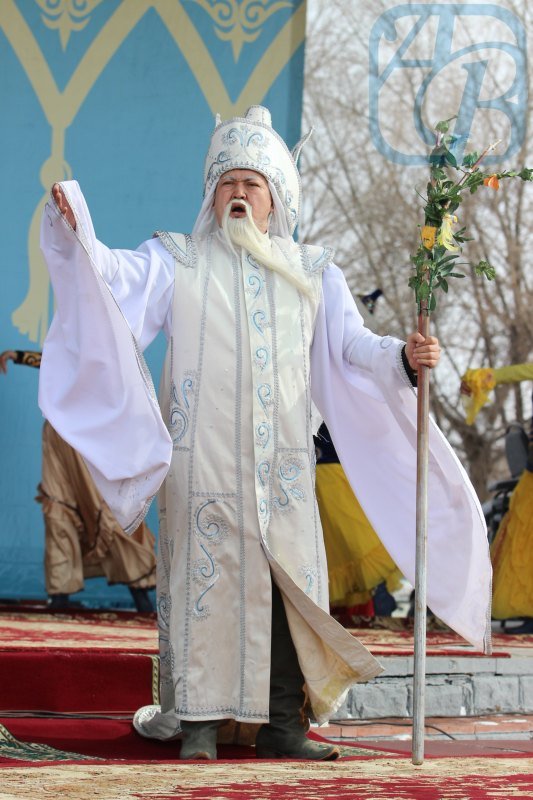
– As far as I know, you have been investigating Nauryz for many years. When you explored this holiday, did you find out how many hidden signs Nauryz has?
– I have been studying and exploring “Nauryz” for about 20 years. Based on the research, the project “Nauryz-Fest” has been developed, that is going to turn 12 years this year. Based on the investigation, the book “Nau men yrys” was published first. Today we had the opportunity to share the main news of these studies. As a basis for this article, I would like to publish 7 important signs of main spring holiday.
The first sign is historical certificate of Nauryz! The ancient inscriptions had carved on the rock in the mountains of the Anrakai ridge, 170 km northwest of Almaty, about 5,000 years ago. It depicts two figures several times larger than the terrestrial creatures: there is a person with a sunrise on the right side, that is probably a bright force called “God”, and there is a person with a sunrise on the left side – a twilight remaining in the form of the concept. In the middle of them, there are the four seasons of the Year of the Cow in a counter-clockwise direction. There is also a newborn calf with a bare head on it, and a fat bull with horns like a pine tree looking at God on its left side. These are the four seasons of the year: spring, summer, autumn and winter, respectively.
Underneath to all of them, there are twelve people in the form of various beasts. The twelve memberships of the image are likely to be the images of twelve moon or 12 constellations. This is a ritual of the ancient Nauryz holiday! This is a celebration of the Year of the Cow! This petroglyph depicts the beginning of the year of membership with the equinox. Nauryz, which has long been equated with Persia, is a universal testimony to this millennium-old stone testimony. In addition, it fully corresponds to the cognition and ethnographic understanding of the Turkic peoples.
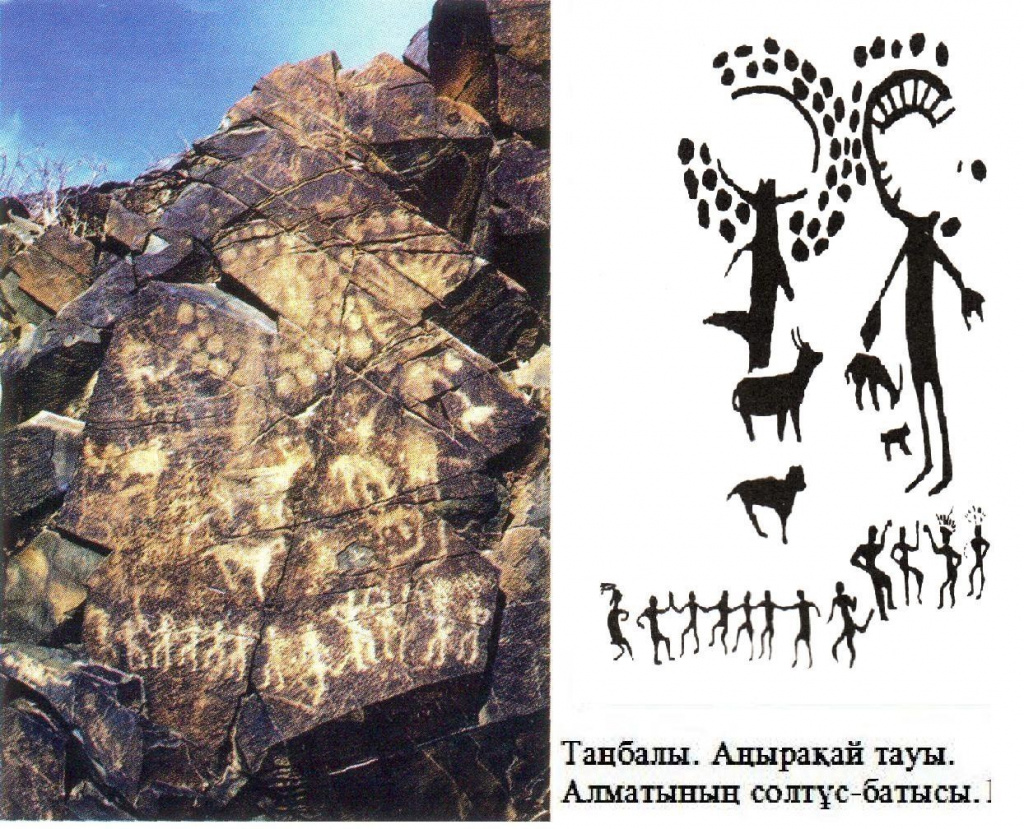
Another sign of Nauryz is Nauryzborik! This hat is on the list of Russian national bas-reliefs on the Russian Basque website, but its name is Nauryz! There is a character of Nauryzborik. Although it can be attributed to one type of beret, the base is sewn together with a hat and a beret; the hat is close to the hat, but has no cross-section, but has an upward facing and decorated the edge with precious stones; A hem of the hat is covered with precious leather. This is not a cap, but a part of a special costume for Nauryz. A hat is a symbol of the moon and the hat is a symbol of the sun. In short, it means that the moon and the sun, the Light and the Darkness are united and equal. This cap is probably a suffix of aristocratic ornaments worn on Nauryz in the Golden Age.
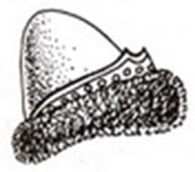
There is another sign, called Nauryzkalpak! It is related to Altynorda, has been found there. It is among the Russian national hats. The character of Nauryzkalpak is the top of the hat that consists of a mixture of two strips; A blue stripe represents the sky and the brown stripe represents the earth. The two separate skirts of the forked hat give the image of the Moon, with a simple cross and the cross embroidered on its surface, that is a symbol of the Sun. A union of the Moon and the Sun indicates the astronomical equinox. This cap is on the list of Russian men's caps from the Golden Age. An image of the man wearing it is also Kipchak, as evidenced by his mustache.
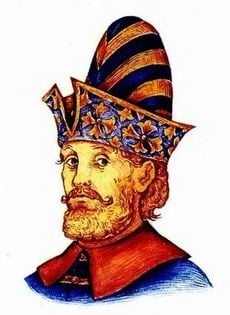
Another sign is “Korisu at the Khan's Horde”. The Kazakh people did not want to see each other only on Nauryz. This is evidenced by the fact that Aral Sea has been studied from June to July 1736, the Ural River, visited the court of Abulkhair Khan and collected several paintings. The table is a picture of two men seeing each other. The time of drawing is clearly indicated as June-July, not March. I guess, these 21-22 dates will be the longest days of June. This day is on the eve of the summer holiday “Sabatoi”, that is forgotten in Kazakh today. It is possible that the artist agreed with him. This is also a significant holiday, that the Sakha-Yakuts call “Isaiah” today and celebrate as their New Year. It is better to tie the farewell to Nauryz than to this picture, so this custom is typical of other seasonal holidays, that coincide with the charm of the Day and Night throughout the year.

The fifth sign of Nauryz is the tradition called “Korisu”. The ancient paintings carved on the Tanbaly rock of the Anyrakai ridge around five thousand years ago, they are located 170 km from northwest of Almaty. Here is the creator of the bright power and night, that is called “God”. A detailed description is given above. They have a tradition of embracing each other. This is definitely a ritual of the ancient “Nauryz” holiday. It is a celebration of global harmony on the eve of the equinox.
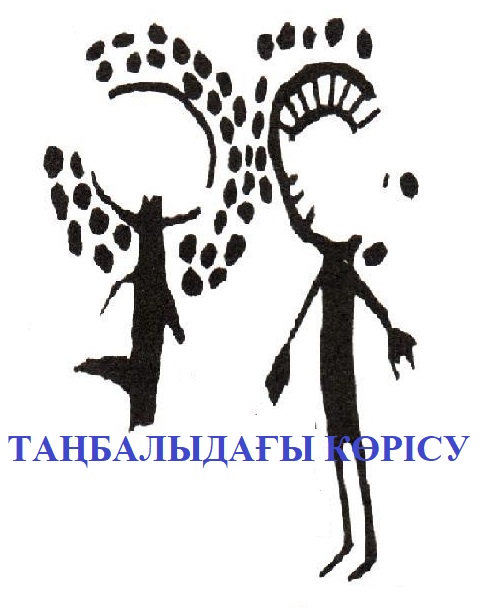
The sixth sign is obviously connected with Altybakan. It is not a game, because there are no special rules of the game. But it has an attribute of 7 bars.
In general, there is a great deal of cosmogonic knowledge in the use of six poles in order to tie their heads vertically in threes and the seventh to connect their heads. According to the legends that have come down to us, the seven planets were created in six days, just as the phenomenon of the formation of the ancient universe that took place in this ceremony! Thus, the fact that our six frogs, six creative days of the universe, and even though the number of poles is seven, there is a sign of respect for the first seven planets. The seventh horizontal bar is a symbol of the Sun, that illuminates and connects the solar system with its rays.
Moreover, the Kazakhs build Altybakan before the sunset, and the ceremony of kicking it begins after the sunset and lasts until dawn. This is a manifestation, an action, a procession of the intention not to give in to evil and darkness.

And the last sign of Nauryz is closely associated with “Bastangy”. It is an entertaining game environment that brings young people together, when adults travel to the long distances. This tradition is mostly carried out in those families who have daughters. At the beginning, the mother gives food for the young people, who visited the house. Otherwise, she is supposed to leave the cattle. In the beginning, the village where the youth gathered, the boys slaughtered the sheep, and the girls laid the table and cooked the dishes. In the evening, they sing, tell the stories to each other, hide the riddles, play a variety of games, and tell the jokes to each other.
This tradition was held, when the girls grew up and became more mature. It has its own educational value. However, the tradition is not reflected today, it has become more common in the past centuries.
When young people gathered at the beginning, they played games, joked, competed in art and had fun. The name of the tradition consists of the words “Bas” and “Tangy”. In the past century, Kazakhs used to wear clothes on their heads when they traveled to the long distances. The beginning of this had started with a fun evening of young people, including not only acquaintances, but also the good intentions of the passengers.
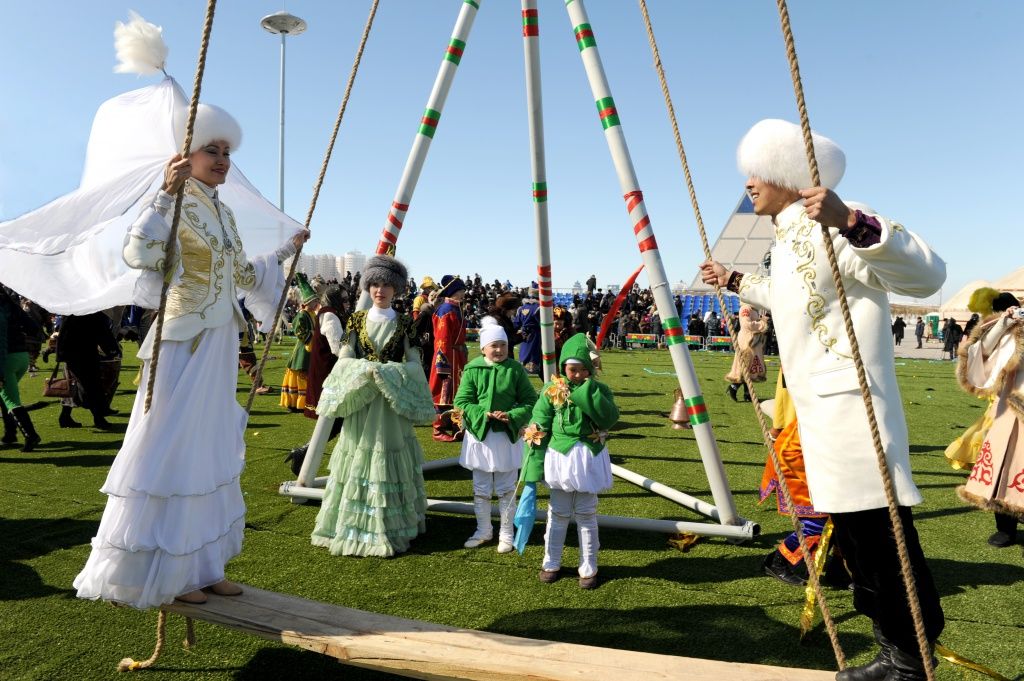
– I heard that you have developed your own concept of celebrating Nauryz, based on the analysis of historical and cultural heritage. Can you tell more about this?
– According to the old style, people started to celebrate Nauryz on March 1, but later they began the celebration on March 14. I would call this day as the day of sunshine, when someone can hold the flower exhibitions and give flowers to women. This is followed by the days of gratitude, purification, abundance, the awakening of nature, radiance, inspiration and harmony. He noted that the residents of the western regions of Kazakhstan celebrate “Amal Holiday” on March 14. In fact, this is a main holiday of spring.
In general, these days, when the spring festival is celebrated, were not chosen by chance, since the Sun approached the star Amal in its orbit at that time (in Arabic, it`s called “Hamal”). It turns out that the Sun enters the sign of Aries in this way and opens a new zodiacal year. It was this period that was considered the beginning of the renewal of nature. During the vernal equinox, the celestial bodies come so close to each other that it seems that they became one. This phenomenon became the basis of the “Korisu”, that has an obligatory tradition of the holiday in Western Kazakhstan. I believe that first of all, it is an astronomical phenomenon and every nation has its own traditions of celebration since the ancient times.
According to my concept, March 19 is considered as the “Day of Prosperity”. On this day, everyone decorates their home with seven colors. The carpets are laid on the place of honor, the rugs are hung on the walls. New clothes, property and furniture are acquired as well.
March 20 is celebrated as the “Day of Joy”. The light, uplifting events, promotions and concerts are held on this day.
March 21 is considered as the “Harmony Day”. On this day you can build a zholterek in your houses or organizations. It is a mythical tree connecting the upper, middle and lower worlds (it is very similar to the “Baiterek” monument).
On this day, the festivities can be held in places of mass festivities. Also, an altybakan can be installed as a ritual instrument symbolizing the seven planets and the harmony of the moon and sun, that is, it personifies night and day.
By the way, people do not sleep and wait for the dawn on the night of March 21-22. At this time, you cannot sleep, you need to wait for the sunrise. Girls can prepare a delicious dish for their beloved ones that is called “Uygyashar”, and guys can give the gifts for the girls, called “Seltetkіzer”, that is literally translated as “Something that makes the heart tremble”. The old people gather for the dastarkhan, sing songs, remember past events that happened to them, greet the morning. In addition to “Nauryz kozhe”, you can prepare the dish “Nauan” for the festive table, that consists of three ingredients. “Nauan” personifies the unity of the three worlds, that will bring a prosperity to the house in which it was prepared.
March 22 is the main morning. All people prepare the special clothes to meet the morning, put on costumes. Waking up early, meeting the morning, they greet the Almighty, his great creation – the Sun, that shows their respect. According to the superstition, “Let there be a lot of light”, a milk is sprinkled on the ground.
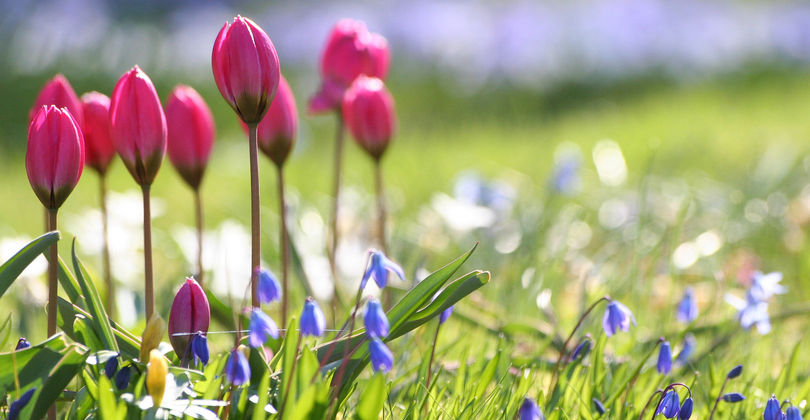
– What actions should be carried out in order to make the celebration of Nauryz more meaningful?
– Nauryz can be cleberated with a carnival (a parade, dedicated to Nauryz), as our distant ancestors did, performing 9 kyuis and organizing sports competitions. Among the games there may be “Zhamby atu” (competition in shooting). Previously, the participants in this ritual game, deifying the sun, shot at the sun-shaped disk – zhamby, and the one who fell into it became the ruler for one day.
In addition to nauryz-kozhe, I propose to prepare the “Nauan” dish for the festive dastarkhan by placing the “Red”, “White” and “Green” dishes on the three-tiered vase – meat, the dairy products and vegetables with fruits as well.
“Nauan” is a cognitive dish, that was conceived as a new way in the New Year's table decoration. The word “Nauan” means big, tall and very good, wonderful, beautiful, but there is no exact interpretation of what it means. Many people consider it as a symbol of ancient mythical knowledge. According to Serik Ergali, “Nauan” also personifies the unity of the three worlds, that will bring wealth and prosperity to the house in which it was cooked.
You can also distribute “Zholdyk” (a special card for Nauryz) in a modern travel report. It is actually a reminder to the guests, acquaintances, as well as a small and simple gift for the participants of the Nauryz event. There are also the superstitious gifts arising from gratitude for the Kazakh New Year. In the ancient times, this tradition was diverse. “Zholterek” had been decorated with fabric, cloth, leather. At the end of the holiday, it was performed as a ritual. Nowadays, the distribution of “Zholdyk” is a part of Eid holiday.
– Thank you so much, for your interview! We would like to wish you a continuous success in your job and a lifelong prosperity for your life!
(Pictures were taken from the personal archive of the culture expert)
 Subscribe to our Telegram channel and be the first to know the news!
Subscribe to our Telegram channel and be the first to know the news!